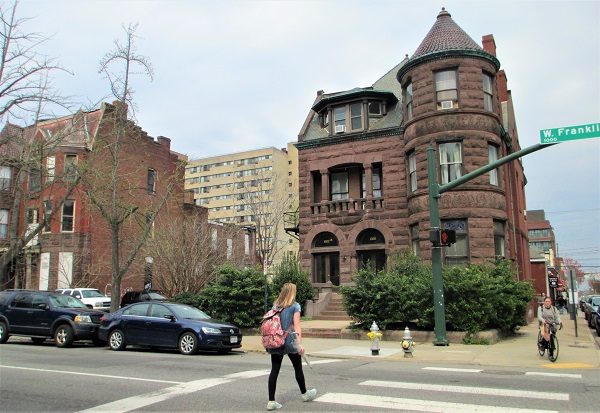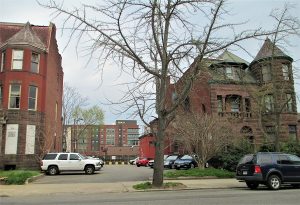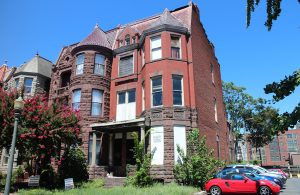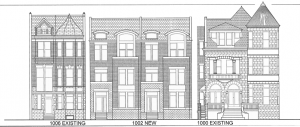
The century-old buildings by the intersection of Franklin and Harrison streets are set to be rehabbed as part of an infill development that would add two new apartment buildings between them. (Photos by Jonathan Spiers)
A surface parking lot in the heart of VCU’s Monroe Park campus appears slated for an infill development that would add new apartments to the neighborhood’s housing stock.
Plans submitted to the city’s Commission of Architectural Review (CAR) show conceptual designs for two new buildings that would fill the existing lot at 1002-1004 W. Franklin St., between two existing buildings at the northwest corner of the busy crossroads of Franklin and Harrison streets.

The parking lot between the buildings would be replaced with surface parking below the new apartments.
Local architect Dave Johannas of Johannas Design Group submitted the plans on behalf of Ronald Nixon, who purchased the properties involved in late 2016 and early 2017. They include the corner building at 1000 W. Franklin St. and another three-story building at 1006 W. Franklin St., both of which would be modified as part of the project.
In addition to adding density to the block, the project would revive 1006 W. Franklin St., a century-old rowhouse that the city declared blighted in 2010 and was among three surplus city-owned properties in the area sold at auction in 2016.
City property records show Nixon, who resides a block away on Franklin and has done several VCU-area rehabs and infills, purchased 1006 W. Franklin St. from the auction winner, K and L Sales LLC, in February 2017 for $355,000. Nixon purchased 1000 W. Franklin St., which includes the parking lot, in November 2016 for $1.4 million.
A city assessment most recently valued the properties at $1.72 million collectively.
Nixon, whose other projects include a recent carriage house addition across Harrison Street – between an existing rowhouse and the building that houses Hibachi Box and Edo’s Squid – deferred comment about the apartments project to Johannas, who noted the impact it would have on the blighted 1006 building.

The rowhouse at 1006 W. Franklin St. was sold in an auction after the city deemed it blighted in 2010. (BizSense file photo)
“Finally, it’s going to be stabilized and come back to life,” Johannas said.
Aimed at student housing
Johannas said the apartments planned for the site would be intended for student housing. He did not provide a range for monthly rental rates but said the units likely would rent higher given their location.
According to the plans, which remain conceptual, the two new buildings facing Franklin likewise would total three stories and house 10 apartments ranging in size from 700 to 1,450 square feet. Parking spaces would be replaced with surface parking that would be located below the apartments and accessible only from a rear alley.
The corner 1000 building would be rehabbed to convert office space on the first floor and in the basement into four apartments, and rework six existing units on the top two floors into five more-spacious floor plans. The 1006 building rehab would result in four apartments ranging in size from 1,200 to 1,800 square feet, accommodated in part by a third-floor rear addition totaling 670 square feet.

A conceptual rendering of the two new buildings between the existing buildings. (Courtesy Johannas Design)
Johannas said the two rehabs would involve historic preservation tax credits that Nixon is pursuing through the Virginia Department of Historic Resources and the National Park Service. He did not disclose a cost estimate for the overall project, which he said likely would see Nixon serving as general contractor on the rehabs and hiring a separate contractor for the new construction.
The project would require a special-use permit from Richmond City Council, which Johannas anticipates introducing and referring to the planning commission in coming months. A sitting planning commissioner, Johannas said he would recuse himself when the SUP comes up for review there.
The plans submitted to CAR are for conceptual review only and are intended to receive preliminary feedback. The plans for 1006 are set to go before CAR today, March 26, while the 1000 rehab and infill plans were on CAR’s agenda last month and are slated to be reviewed again in April.
The project adds to other infill developments adding residential density in and around the Fan.
Along Ellwood Avenue across Arthur Ashe Boulevard, Richmond Hill Design Build is adding five new attached homes and rehabbing an adjacent detached home a block north of Carytown. On Park Avenue in the Fan, Reid Pierce of Pierce Development is wrapping up work on three contemporary-style homes beside a 1920 house he’s restoring.
Infill residential projects are popping up in other parts of the city as well. In the Shockoe area, Margaret Freund’s Fulton Hill Properties recently submitted plans to CAR for two stories’ worth of apartments planned above the Buffalo Wild Wings at the firm’s Canal Crossing complex.

The century-old buildings by the intersection of Franklin and Harrison streets are set to be rehabbed as part of an infill development that would add two new apartment buildings between them. (Photos by Jonathan Spiers)
A surface parking lot in the heart of VCU’s Monroe Park campus appears slated for an infill development that would add new apartments to the neighborhood’s housing stock.
Plans submitted to the city’s Commission of Architectural Review (CAR) show conceptual designs for two new buildings that would fill the existing lot at 1002-1004 W. Franklin St., between two existing buildings at the northwest corner of the busy crossroads of Franklin and Harrison streets.

The parking lot between the buildings would be replaced with surface parking below the new apartments.
Local architect Dave Johannas of Johannas Design Group submitted the plans on behalf of Ronald Nixon, who purchased the properties involved in late 2016 and early 2017. They include the corner building at 1000 W. Franklin St. and another three-story building at 1006 W. Franklin St., both of which would be modified as part of the project.
In addition to adding density to the block, the project would revive 1006 W. Franklin St., a century-old rowhouse that the city declared blighted in 2010 and was among three surplus city-owned properties in the area sold at auction in 2016.
City property records show Nixon, who resides a block away on Franklin and has done several VCU-area rehabs and infills, purchased 1006 W. Franklin St. from the auction winner, K and L Sales LLC, in February 2017 for $355,000. Nixon purchased 1000 W. Franklin St., which includes the parking lot, in November 2016 for $1.4 million.
A city assessment most recently valued the properties at $1.72 million collectively.
Nixon, whose other projects include a recent carriage house addition across Harrison Street – between an existing rowhouse and the building that houses Hibachi Box and Edo’s Squid – deferred comment about the apartments project to Johannas, who noted the impact it would have on the blighted 1006 building.

The rowhouse at 1006 W. Franklin St. was sold in an auction after the city deemed it blighted in 2010. (BizSense file photo)
“Finally, it’s going to be stabilized and come back to life,” Johannas said.
Aimed at student housing
Johannas said the apartments planned for the site would be intended for student housing. He did not provide a range for monthly rental rates but said the units likely would rent higher given their location.
According to the plans, which remain conceptual, the two new buildings facing Franklin likewise would total three stories and house 10 apartments ranging in size from 700 to 1,450 square feet. Parking spaces would be replaced with surface parking that would be located below the apartments and accessible only from a rear alley.
The corner 1000 building would be rehabbed to convert office space on the first floor and in the basement into four apartments, and rework six existing units on the top two floors into five more-spacious floor plans. The 1006 building rehab would result in four apartments ranging in size from 1,200 to 1,800 square feet, accommodated in part by a third-floor rear addition totaling 670 square feet.

A conceptual rendering of the two new buildings between the existing buildings. (Courtesy Johannas Design)
Johannas said the two rehabs would involve historic preservation tax credits that Nixon is pursuing through the Virginia Department of Historic Resources and the National Park Service. He did not disclose a cost estimate for the overall project, which he said likely would see Nixon serving as general contractor on the rehabs and hiring a separate contractor for the new construction.
The project would require a special-use permit from Richmond City Council, which Johannas anticipates introducing and referring to the planning commission in coming months. A sitting planning commissioner, Johannas said he would recuse himself when the SUP comes up for review there.
The plans submitted to CAR are for conceptual review only and are intended to receive preliminary feedback. The plans for 1006 are set to go before CAR today, March 26, while the 1000 rehab and infill plans were on CAR’s agenda last month and are slated to be reviewed again in April.
The project adds to other infill developments adding residential density in and around the Fan.
Along Ellwood Avenue across Arthur Ashe Boulevard, Richmond Hill Design Build is adding five new attached homes and rehabbing an adjacent detached home a block north of Carytown. On Park Avenue in the Fan, Reid Pierce of Pierce Development is wrapping up work on three contemporary-style homes beside a 1920 house he’s restoring.
Infill residential projects are popping up in other parts of the city as well. In the Shockoe area, Margaret Freund’s Fulton Hill Properties recently submitted plans to CAR for two stories’ worth of apartments planned above the Buffalo Wild Wings at the firm’s Canal Crossing complex.



REALTOR Emeritus
fill’em up! it will be nice to see every parking lot and empty lot with street frontage filled to the max with housing and neighborhood services.